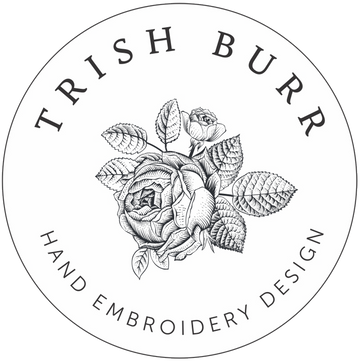MATERIALS FOR EMBROIDERY
Blocking your embroidery
There may be times when your embroidery is complete that it needs cleaning, has marks on or has a stubborn hoop mark and you will need to wash it and then block it to restore it to its original shape.
- Soak your embroidery in tepid water and a mild detergent for about 15 mins.
- Rinse thoroughly in cold water.
- Roll the wet piece of fabric in a fluffy towel to remove excess moisture.
To block your embroidery
Only recommended for colorfast threads.
- Place your damp fabric on a surface such as cork/foam board – make sure it has a straight edge.
- Line your embroidery up on the straight edge on one side and place pins all along this edge.
- Do the same thing on the bottom edge and then both side edges.
- Leave till it is completely dry.
- When it is dry remove pins and if necessary press with a medium iron on the wrong side.
- If your embroidery is dry you can spray it with water when blocking.

NEEDLES
You will need Sharps size 10 embroidery needles for your project. These are available in the store or you can purchase your own. The Embroidery Essentials File that comes with your PDF pattern will give more detail.
Download the John James Needle Guide here.


HOOPS & FRAMES

How to use a super grip hoop
- Place the inner hoop with the lip facing up towards you on a flat surface.
- Place the fabric on top of this - ensure the design is centered.
- Place the outer hoop on top of this. Push down till you feel the outer hoop slip over the lip of the inner hoop.
- Tighten the screw and adjust the fabric till it is drum tight.
How to use a stretcher frame.

MAGNIFYING LIGHT
It is virtually impossible to see the tiny little stitches in your embroidery without the help of a magnifying light, it reduces eyestrain and I highly recommend you use one, it will be the best investment you ever made!
There are many lights on the market, you could begin by looking online at places like Amazon or any craft/needlework stores. Here are some pointers when buying a light.
1. It should have daylight or white light not yellow light from a light bulb, so it does not distort the colours in your project.
2. LED lights are best - but the light should have at least 21 LED bulbs. Any less will not give the required light.
3. It should have magnification of at least 1.5.
4. The light face should be large enough for you to see through comfortably.
5. You should be able to sit comfortably in your chair whilst stitching and the light should reach you - you should not have to bend towards the light.
I have a slimline LED magnifying lamp from the Daylight company. It has a 13cm (5 in) lens with 1.75 magnification. FInd on Amazon.

You could also use something like this Purelite 3 in one which is a bit more portable.

DO NOT BUY ONE OF THESE. The light is not strong enough and the lens will be too small.



